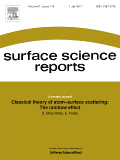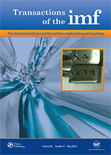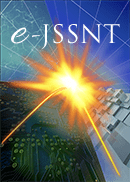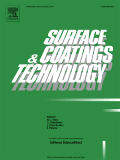
SURFACE SCIENCE REPORTS
Scope & Guideline
Unveiling the Complexities of Surface Properties
Introduction
Aims and Scopes
- Surface Characterization Techniques:
The journal emphasizes innovative techniques for characterizing surfaces at the atomic and molecular levels, including spectroscopy, microscopy, and scattering methods. - 2D Materials and Their Interfaces:
A core area of focus is the study of two-dimensional materials, such as graphene and transition metal dichalcogenides, and their interactions with surfaces, which have implications in electronics and catalysis. - Catalyst Design and Surface Reactions:
Research on the design and optimization of catalysts through surface chemistry and reaction mechanisms is a consistent theme, showcasing the interplay between surface properties and catalytic performance. - Interfacial Phenomena:
The journal addresses various interfacial phenomena, including liquid-solid and solid-gas interfaces, exploring how these affect material properties and reactions. - Emerging Materials and Technologies:
Surface Science Reports is dedicated to highlighting new materials, such as metal oxides and nanostructures, and their potential applications in technology, energy, and environmental science.
Trending and Emerging
- Advanced Spectroscopic Methods:
There is a growing trend towards the application of advanced spectroscopic techniques, such as synchrotron-based photoelectron spectroscopy and tip-enhanced Raman spectroscopy, for detailed surface analysis. - Complex Catalyst Design Strategies:
Emerging themes include sophisticated approaches to catalyst design that integrate complex surface interactions and new materials, moving beyond traditional volcano plots and scaling relations. - Interactions of 2D Materials with Surfaces:
The exploration of two-dimensional materials and their unique properties when interfaced with various substrates is gaining momentum, as researchers investigate their potential in electronics and nanotechnology. - Surface Chemistry of Emerging Technologies:
Research focusing on the surface chemistry of novel technologies, such as electrochemical interfaces and nanostructures, is increasingly relevant as the demand for innovative solutions in energy and materials science rises. - Geochemical Interfaces and Environmental Impact:
An emerging focus on geochemical interfaces reflects a growing interest in understanding surface phenomena in environmental contexts, highlighting the importance of surface science in addressing global challenges.
Declining or Waning
- Traditional Bulk Material Studies:
Research focusing predominantly on bulk materials rather than surface phenomena has decreased, as the journal shifts towards more surface-specific investigations and nanostructured materials. - Classical Catalysis Theories:
There is a noticeable decline in papers centered around classical theories of catalysis that do not incorporate modern surface science techniques or insights, as the field evolves towards more complex and dynamic models. - Surface Properties of Simple Molecules:
Studies investigating the surface properties of simple or well-established molecules are becoming less frequent, as the journal prioritizes more complex systems and novel materials.
Similar Journals

TRANSACTIONS OF THE INSTITUTE OF METAL FINISHING
Unveiling Breakthroughs in Metal Finishing TechniquesTRANSACTIONS OF THE INSTITUTE OF METAL FINISHING, published by Taylor & Francis Ltd, is a premier journal dedicated to the field of metal finishing and surface engineering. With an ISSN of 0020-2967 and E-ISSN of 1745-9192, this journal has been a critical resource for researchers and practitioners since its inception in 1969. Covering a broad scope that includes condensed matter physics, mechanics of materials, and the intricate science of metals and alloys, TRANSACTIONS OF THE INSTITUTE OF METAL FINISHING has established itself within the academic community, currently holding Q2 and Q3 rankings across multiple relevant categories in 2023. While not openly accessible, the journal remains a vital compendium of innovative research findings and advancements, attracting contributors and readers eager to explore cutting-edge developments in metal finishing techniques and applications. The insightful articles published here cater to a wide audience, including industry professionals, academic researchers, and students, who seek to improve their understanding of materials science and engineering practices.

Advanced Materials Interfaces
Connecting Ideas, Innovating InterfacesAdvanced Materials Interfaces is a premier journal dedicated to the exploration and advancement of materials science, with particular emphasis on the interfacial phenomena that govern the behavior of materials in various engineering applications. Published by WILEY in the United Kingdom, this Open Access journal, established in 2014, has quickly ascended to a Q1 category ranking in both Mechanical Engineering and Mechanics of Materials as of 2023, reflecting its significant influence and excellence in the field. With impressive Scopus Ranks, such as #81 out of 672 in Mechanical Engineering and #58 out of 398 in Mechanics of Materials, it serves as a vital resource for researchers and practitioners aiming to push the boundaries of materials innovation. The journal provides unrestricted access to its cutting-edge research, promoting collaboration and dissemination of knowledge among the global scientific community, solidifying its role as a vital contributor to the ever-evolving landscape of materials engineering.

e-Journal of Surface Science and Nanotechnology
Advancing Knowledge in Surface Science and NanotechnologyThe e-Journal of Surface Science and Nanotechnology, published by the SURFACE SCI SOC JAPAN, stands as a pivotal platform for the dissemination of groundbreaking research in the fields of surface science and nanotechnology. With an ISSN of 1348-0391 and a commitment to open access publication since 2003, this journal ensures that innovative findings are accessible to a global audience, fostering collaboration among researchers, professionals, and students. The journal spans a wide array of disciplines, as evidenced by its 2023 category quartiles, which include Q3 rankings in Biotechnology and Mechanics of Materials, as well as Q4 standings in Bioengineering, Condensed Matter Physics, and various surface-related fields. This diverse scope makes it an essential resource for those engaged in advanced scientific research and applications. The journal’s unique position within its categories—Ranging from Q3 to Q4 in various Scopus rankings—highlights its niche yet vital contribution to advancing knowledge in both fundamental and applied sciences. By continually converging from 2005 to 2024, the e-Journal of Surface Science and Nanotechnology embodies the integration of innovative studies and novel applications that drive the future of material sciences.

SURFACE & COATINGS TECHNOLOGY
Transforming Ideas into Advanced Coating SolutionsSURFACE & COATINGS TECHNOLOGY is a premier academic journal that has been at the forefront of research and innovation since its inception in 1986, diligently published by Elsevier Science SA. With an impressive range of studies focusing on surface and coatings technologies, the journal has established itself as a leading platform within the fields of Chemistry, Condensed Matter Physics, and Materials Science. Notably, it holds a distinguished Q1 ranking in multiple categories, showcasing its relevance and high impact in the academic community. Furthermore, it is recognized for its rigorous peer-review process and is indexed in esteemed databases, maintaining its strong position with a ranking of #17 in Surfaces, Coatings, and Films. Although the journal does not currently offer open access options, it continues to be a crucial resource for researchers, professionals, and students seeking insights into cutting-edge developments and applications in the domain of surface engineering. With a commitment to advancing knowledge across these disciplines, SURFACE & COATINGS TECHNOLOGY is an essential read for anyone interested in the latest trends and technologies shaping the industry.

International Journal of Surface Science and Engineering
Exploring the Frontiers of Surface InnovationThe International Journal of Surface Science and Engineering, published by INDERSCIENCE ENTERPRISES LTD, serves as a vital platform for researchers and professionals in the field of mechanical engineering, surfaces, coatings, and materials science. With an ISSN of 1749-785X and an E-ISSN of 1749-7868, this journal disseminates innovative research addressing the challenges and advancements in surface technologies and engineering practices. Its scope includes, but is not limited to, surface coatings, interface properties, and novel material applications. Since its inception in 2007, the journal has established a solid reputation, achieving a Q3 ranking in Mechanical Engineering and Surfaces, Coatings and Films, and a Q4 ranking in Surfaces and Interfaces as of 2023. These metrics underscore the journal's growing influence, despite being positioned within the Q3 and Q4 quartiles of its categories. The International Journal of Surface Science and Engineering provides a curated collection of high-quality articles that contribute significantly to the understanding of surface phenomena, fostering collaboration and advancements in the field. Researchers, professionals, and students alike will find this journal an indispensable resource for cutting-edge developments and in-depth analyses.

CHEMISTRY OF MATERIALS
Exploring Innovative Pathways in ChemistryChemistry of Materials, published by the American Chemical Society, stands at the forefront of innovative research in the disciplines of chemical engineering, materials science, and chemistry. With an impressive impact factor, this esteemed journal is recognized globally, having achieved Q1 rankings in three significant categories for 2023: Chemical Engineering, Materials Chemistry, and General Chemistry. This positions the journal in the top tier of academic publications, reflecting its influence and rigor in advancing the field. Since its inception in 1989, Chemistry of Materials has been a platform for groundbreaking studies, contributing essential insights and discoveries that shape modern materials science. While currently not an open-access journal, it remains an invaluable resource for researchers, professionals, and students seeking to explore cutting-edge materials research and applications. Its well-curated collection of articles underscores the journal's commitment to enhancing understanding and promoting innovations in material chemistry and its associated fields.

SURFACE REVIEW AND LETTERS
Unveiling Insights in Surface ScienceSURFACE REVIEW AND LETTERS, published by WORLD SCIENTIFIC PUBL CO PTE LTD, is a pivotal journal in the fields of condensed matter physics, materials chemistry, and surfaces and interfaces. With an ISSN of 0218-625X and an E-ISSN of 1793-6667, this journal serves as a platform for cutting-edge research and innovative developments from 1996 to 2024. Despite its classification in the Q4 and Q3 quartiles for various categories in 2023, SURFACE REVIEW AND LETTERS emphasizes the importance of inter-disciplinary collaboration and the rapid dissemination of valuable insights, making it an essential resource for researchers and professionals eager to stay at the forefront of material science. Although currently lacking an open access option, the journal invites a wide range of submissions—fostering knowledge sharing among scholars and contributing to the advancement of the scientific community. Aspiring authors and readers will benefit from the opportunity to engage with diverse studies and methodologies, underscoring the journal's commitment to excellence in materials research.

Korean Journal of Metals and Materials
Advancing the Frontiers of Metals and Materials ScienceWelcome to the Korean Journal of Metals and Materials, a premier publication dedicated to advancing research in the interdisciplinary fields of metals and materials science. Published by the Korean Institute of Metals and Materials, this journal aims to foster the dissemination of innovative findings and significant developments across various domains, including electronic, optical, and magnetic materials, metals and alloys, as well as modeling, simulation, and surface coatings. With a commendable Q3 quartile ranking in several relevant categories as of 2023, it serves as a vital resource for researchers, professionals, and students interested in the latest scientific trends and technological applications. The journal has successfully converged from 2007 to 2024, showcasing a rich archive of knowledge. Engaging with this publication gives readers the opportunity to stay updated with critical advancements and enhances collaboration within the vibrant materials science community. Access is available through various platforms, ensuring that our content is widely accessible to all those striving for excellence in the field.

Surfaces is an esteemed academic journal published by MDPI in Switzerland, operating as an open access platform since 2018. With an E-ISSN of 2571-9637, this journal focuses on the interdisciplinary advancements in the fields of chemistry, materials science, and physics, particularly in the domain of surfaces and interfaces. As a testament to its scholarly impact, Surfaces is ranked in the second quartile for multiple categories as of 2023, including Chemistry (miscellaneous), Materials Science (miscellaneous), Surfaces and Interfaces, as well as Surfaces, Coatings and Films, showcasing its relevance within these disciplines. Researchers and professionals seeking to disseminate and acquire knowledge on the latest innovations can benefit from the journal's rigorous peer-review process and commitment to quality, ensuring visibility and accessibility for current developments in surface technology and material interactions. With a growing archive from 2019 to 2024, Surfaces stands out as a vital resource for the academic community.

COLLOID JOURNAL
Pioneering research in colloidal systems for a deeper understanding.COLLOID JOURNAL, published by PLEIADES PUBLISHING INC in the United States, is a pivotal platform for disseminating cutting-edge research in the fields of Colloid and Surface Chemistry, Physical and Theoretical Chemistry, and Surfaces and Interfaces. With an ISSN of 1061-933X and E-ISSN 1608-3067, this journal offers a valuable resource for researchers and professionals seeking to explore advancements in colloidal systems and surface phenomena. Although currently categorized in the lower quartiles (Q4) within its respective fields, the journal serves as an essential space for emerging ideas and methodologies, contributing to the broader understanding of material interactions at the micro and nano scales. The H-index and specific impact factor data are yet to be determined, but the journal maintains a dedication to high-quality peer-reviewed content that continues to shape the landscape of colloid science. Researchers and students alike will find the COLLOID JOURNAL an indispensable reference for keeping abreast of the latest developments, despite the absence of open access options, reflecting the journal's traditional publishing model. With converged years from 1989 to 2024, it represents a long-standing commitment to scholarly dissemination and exploration in its fields of study.